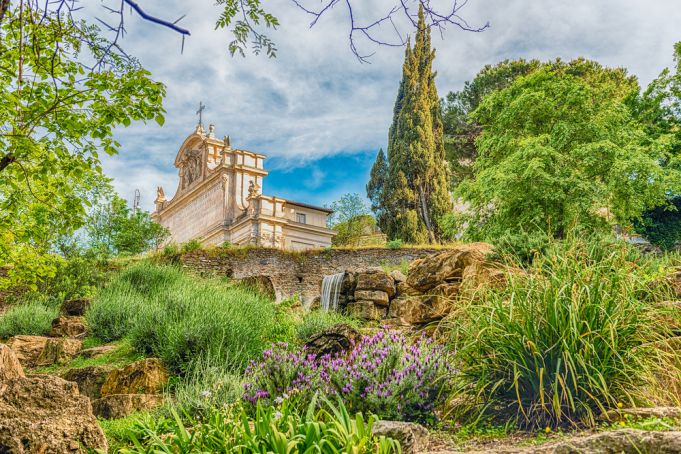All you need to know about Rome's Botanic Garden.
The Orto Botanico in Rome's Trastevere district offers a beautiful escape from the bustle of the city’s streets.
For images of paradise, visitors flock to the Sistine Chapel and Vatican Museums. Yet the Orto Botanico, its azure flecked with parakeets – a recent invasive species – provides an earthly alternative for which you needn’t stand in line.
From Piazza Trilussa in Trastevere turn right into Via della Lungara and then left into Via Corsini where a magnificent magnoglia grandiflora vies for height with the Galleria Nazionale di Arte Antica (also known as Galleria Corsini).
Where the cobblestones stop is the ticket-office. Traffic suddenly gives way to birdsong while along the Orto’s farmost rim, Garibaldi (or his statue) can be seen riding the tree-line.
In other words, “rus in urbe”, a phrase coined by Martial in an epigram in which the poet, tired of the din around his garret in the Suburra, envies his friend Sparsus’s country-style manor here upon the Gianicolo and its conduciveness to a good night’s sleep.
Rome meets the world
Follow well-marked gravel pathway pathways and Rome meets the world. Antique and headless busts rub shoulders with cycads from South Africa’s Eastern Cape and Mexican cacti. (Labels – VU, vulnerable; EN, endangered; LC, least concern – show the garden’s protective as well as aesthetic function.)
Here Encephalartos lehmanni, “threatened by goats, porcupines and poachers in its native habitat”, grow in peace. Overhead a droopy Atlantic cedar from Morocco resembles an evergreen weeping willow.
Nearby there’s a stand of bottle-trunked Liquidambars from Turkey and Rhodes, their gum said to induce prophetic dreams. Past the Orangery presides a more local Quercus suber or cork-oak. Pliny the Elder venerated the species as being older than Rome itself.
Indeed, Gianicolo’s oak-forest predates Neolithic times; 300 years old, this 25-m high tree is something of a stripling.

The carnivorous plants deployed nearby are, thank goodness, comparatively miniscule, capturing and eating, as they do, insects, frogs, lizards, even rodents. (Not, though, the woolly – and wily – fruit bat: in exchange for a place to roost, it offers Borneo’s pitcher plant Nepenthes Hemsleyiana not its flesh but its faeces, both parties benefitting from an ingenious if unlikely form of rent.)
Venus flytrap
The Orto’s Dionaea species are mostly North American, including the Venus flytrap, which Darwin designated the world’s most spectacular plant. Confined to habitats short of nutritious nitrates, they use enzymes to feast on meat, thus compensating for what other plants derive from the soil.
Complementing them are various Sarraceniae, whose flute-like tubes are coloured and perfumed like vegetal lingerie to tempt the hapless victim, a green operculum or lid preventing escape. From small to tall, in the aptly-named “Monumental Greenhouse” behind, Madagascan cacti dangle into the iron-ribbed dome.
Back on the path outside, South Africa’s Strelitziaceae with its orange and purple crested flowers suggests some long-beaked bird. More exotics await in the Corsini cactus house. Temperature increasing a dozen degrees, specimens prickle and flower brilliant mauve, red or yellow. Namibia, Kenya, Zanzibar, Transvaal and Mexico (which boasts 900 species of cacti) all are represented. A Bolivian succulent resembles a long bristling snake.
Water garden
Past the water-garden, at close quarters one can observe the Wollemia nobilis or “dinosaur tree”. Until 1994 it was deemed extinct; then Australian explorer David Noble found some hidden away in a ravine in Australia’s Wollemi national park; hence the name. A mind-bending statistic traces fossils of the species to 90 million years ago. (The Orto affords Rome’s best opportunity for extreme time-travelling.)
Another once seemingly defunct tree on show is China’s Metasequioa glyptostroboides: 5,000 years from “extinction” date, lo and behold, specimens were found still growing strong beside the Yangtze. In 1944 a seed was brought to Italy for planting. Every leaf tells a story, to graft a phrase. Or, in Wollemia’s case, every needle.
Tropical Greenhouse
And so, matching the culinary Garden of the Senses on the Orto’s opposite side, one reaches the Garden of Simples. Their purposes listed from Analectic (for the nervous system) to Vulnerary (for healing wounds), the plants were used by mediaeval monks to prepare medicine.
Tucked behind is the evocatively muggy Tropical Greenhouse, humidity a fixed 80 per cent. Weekdays find often no visitor in sight. Easy then to imagine oneself a latter-day Livingstone and Stanley as two stewy green ponds double as mini-Lake Victoria and Tanganyika. From the water rises a spikily spectral trunk to enhance the effect.
Theatre of Greenery
Again in the temperate outdoors, the path climbs into the Mediterranean wood, more native cork-oaks, ilex and laurels replicating the Gianicolo of Neanderthal times and before. At the top nature meets art in Ferdinando Fuga’s 18th century “Stairway of the Eleven Spouts” – “Theatre of Greenery” is the official pamphlet’s phrase.
Flanked by Rome’s most majestic plane trees, the spot features in Paolo Sorrentino’s upcoming season of The New Pope, complete with climbing red-robed cardinals, Rome's Grande Bellezza recurring when least expected. Less idyllically, and a link with Garibaldi’s statue above, it was also an 1849 battle-site as French soldiery laid into the heroes of Rome’s short-lived Republic (see the old print at the stairway’s lower entrance).

Or “Trace the internal organs of Popes in the Santi Vincenzo e Anastasio church”. A 101st thing to do – if that’s not too energetic a word – might be to take a pisolino or nap in the shade of any of the Orto’s 5,000 trees. The Handkerchief Tree, Davidia involucrata, nicknamed for its strangely shaped foliage; the Parrot Tree, Erythina crista-galli; the fore-mentioned Liquidambar for prophetic dreams: each could serve.
Montezuma cypress
Or the Montezuma cypress planted in 2016 in a joint venture by the Mexican and Italian governments.Promising greater things to come is a photo of the Mexican Ahuehuele or water-tree, with a trunk that after two millennia is 40 metres wide, taking 30 people’s outstretched arms to embrace it. Another Mexican gift, some striplings are growing the Orto’s nursery.
Worth a night in a fancy hotel, you might prefer your shut-eye beneath one of the Phoenix palms in whose fronds the mythical bird was said to nest.
You could also choose the fan-leafed gingko tree. Another living fossil, its forebears are as old as the dinosaurs, making Orto Botanico, at least in part, a real-life Jurassic Park. (For a siesta, however, the neighbouring Nannorrhops from Pakistan may be ruled out; its weird trunk, part-python part-gigantic-spider, is entirely horizontal.)
Italian vines
Refreshed, one can stroll past the fern collection to savour the Orto’s array of 150 Italian vines, from Sicily’s Nero d’Avola to Alto Adige’s Müller Thurgau. Luca Maroni, wine-maker and part-time curator, explains how they were only planted in 2016, so they need a couple more years to mature. Then it’s up past the bamboo section, with 70 of Europe's largest species.
Japanese Garden
Turn right for the Rock Garden, inherited from the convent of S. Pietro in Montorio beyond the ridge. Amidst the rocks and gently plashing water of next door’s Japanese garden, another haiku springs to mind: “Beneath the branches/of the cherry trees/ strangers do not exist” – Issa, 1763-1827.
The pavilion offers views not of Mount Fuji but of Rome, a side-panel to guide the gaze. Bookmarking one end of the panorama is the dome of S. Carlo al Corso, while at the other end rears Vittorio Emanuele’s horse. Exactly in the centre is St Peter’s and the Vatican, prompting the pleasant question, which is the greater wonder? Here or there? Nature or art?
Leaving aside Raphael’s epitaph, “Nature feared to be outdone while he lived, and when he died feared she herself would die,” the winning edge surely rests with nature, whether for variety or aesthetics. Art, architecture or sculpture, no matter how perfect, remain constant whereas nature is in a continuous and often spectacular state of change.
Return in autumn: that gingko will blaze orient gold. In two years Luca Maroni’s vines will have reached full height; in two centuries the Wollemia nobilis will be on its way to a sky-touching 40 metres.
General Info
View on Map
Rome's Botanic Garden: a semi-forgotten wonder
Largo Cristina di Svezia, 23 A - 24, 00165 Roma RM, Italy


















